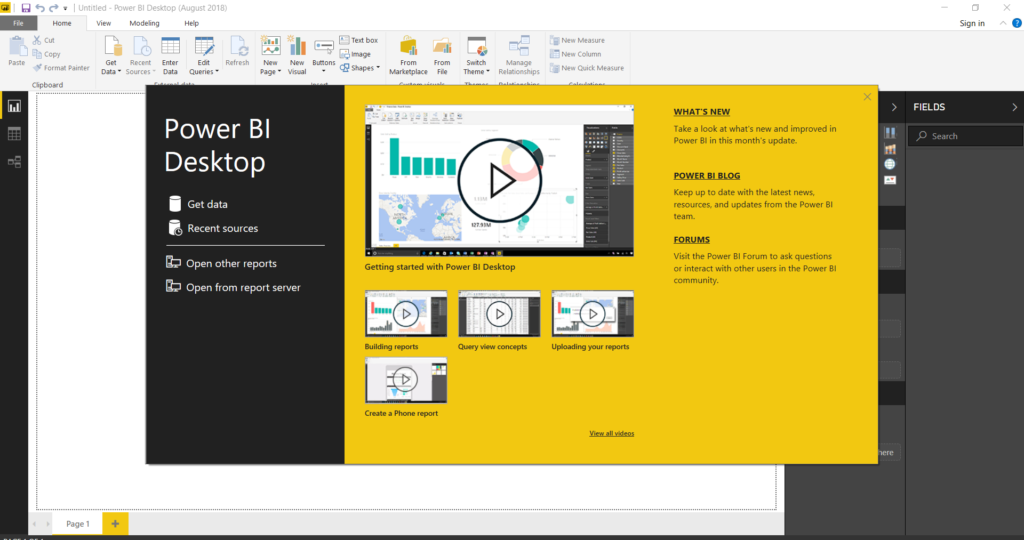

- #POWER BI DESKTOP FOR REPORT SERVER LICENSE KEY#
- #POWER BI DESKTOP FOR REPORT SERVER INSTALL#
- #POWER BI DESKTOP FOR REPORT SERVER PRO#
- #POWER BI DESKTOP FOR REPORT SERVER SERIES#
NOTE: An important purchasing footnote is that although it is an on-premises report server, you must still purchase Power BI Pro licenses for any report authors that will be publishing Power BI reports to your production server(s). Therefore, if you have ten report authors, but only two individuals handle publishing to Production, then only two Power BI Pro licenses are required.
#POWER BI DESKTOP FOR REPORT SERVER LICENSE KEY#
If you already have SQL Server Enterprise and active SA, you can obtain your license key from the Microsoft Volume Licensing Service Center (VLSC).įor more information on SQL Server licensing or Software Assurance benefits, check out Microsoft’s SQL Server licensing guide and datasheet. The other way to acquire Power BI Report Server is by purchasing SQL Server Enterprise edition with active Software Assurance (SA). WHAT’S THE OTHER WAY TO ACQUIRE POWER BI REPORT SERVER? Acquiring Power BI Report Server via this method sets that stage for a hybrid Power BI implementation, which is a topic we will discuss further in a subsequent blog post.
#POWER BI DESKTOP FOR REPORT SERVER INSTALL#
This will give you the ability to install and configure an on-premises Power BI Report Server to compliment your cloud premium capacity. The Microsoft preferred way is via purchasing Power BI Premium capacity within the Power BI Service.

There are currently only two ways to acquire Power BI Report Server. Unfortunately, Power BI Report Server cannot be purchased directly as a standalone product. YEAH, THAT’S GREAT, BUT HOW DO WE PURCHASE POWER BI REPORT SERVER? Power BI assets and functionality such as Dashboards and Q&A are only available in the Power BI Service.įigure 3 - Power BI Report Server only includes Power BI Reports. In terms of Power BI assets, only Power BI Reports can be deployed to the Power BI Report Server. Additionally, this means you can easily migrate an existing SSRS implementation to Power BI Report Server. SSRS FRAMEWORKĪs illustrated above, Power BI Report Server is also built atop the SSRS framework, thus allowing you to deploy SSRS reporting assets such as paginated reports, mobile reports, KPIs, and Excel workbooks to your Power BI Report Server. Power BI Service, which is hosted by Microsoft. Unlike the Power BI Service, which is a cloud-based analytics platform hosted by Microsoft, or Power BI Premium, which is simply dedicated cloud capacity within the Power BI Service, Power BI Report Server is a product that is installed and configured on a dedicated on-premises server.įigure 2 - Power BI Report Server is 100% "in-house" vs. Let’s take a closer look at each of those. The key words in that previous sentence are “on-premises”, “SSRS framework” and “Power BI Reports”. Power BI Report Server is an on-premises product based on the SQL Server Reporting Services (SSRS) framework which allows hosting, sharing, and collaborating on Power BI Reports, all behind your organization’s firewall. WHAT IS POWER BI REPORT SERVER?įigure 1 - SSRS + Power BI Reports = Power BI Report Server! Our aim with this recap is to put those questions to bed by illustrating key points.

“War stories” from an actual large-scale Power BI Report Server implementationĮven with our introduction to Power BI Report Server blog post, we still received quite a few questions about what Power BI Report Server even is.Hybrid Power BI implementation scenarios (Service & Report Server).How Power BI Report Server modernizes your on-premises BI solution.Our goal is to provide further education on the product by focusing on topics such as: The post was well-received and made it evident that people are looking to learn more about the product.

Last year, we wrote a blog post that introduced the Power BI Report Server.
#POWER BI DESKTOP FOR REPORT SERVER SERIES#
This blog post serves as the first in a series on the topic of Power BI Report Server, an underrated addition to the overall Power BI product family.


 0 kommentar(er)
0 kommentar(er)
